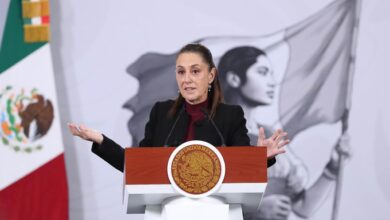AMLO Reaffirms His Power In The Regional Elections. Will He Win In 2024?
Morena, the party of Andrés Manuel López Obrador (AMLO), won big in the last Mexican regional elections.

Photo: TW-lopezobrador_
LatinAmerican Post | Santiago Gómez Hernández
Listen to this article
Leer en español: AMLO reafirma su poder en las elecciones regionales. ¿Todo consumado para una victoria en 2024?
The next Mexican presidential elections are barely on the horizon. In 2 years, Mexicans will elect the president of the first power in Latin America and the second-largest power in all of Latin America, only behind Brazil.
However, despite how distant the next presidential electoral disputes may seem, each of the battles in between is a good thermometer of the approval of the ruling party and the opposition parties.
For now, recently, Morena has emerged stronger after the regional elections by winning 4 of the 6 states in which they were elected governor. While the traditional PAN and PRI parties could only keep one each. Thus, Hidalgo, Tamaulipas, Quintana Roo and Oaxaca strengthen AMLO's hegemony. All these states passed from the hands of the opposition to the ruling party.
While the PAN was barely able to keep Aguascalientes, the smallest state in the republic, but with an important weight in industry. For its part, the PRI achieved victory in Durango in coalition.
In addition, it left the Party of the Democratic Revolution without governors in the entire Mexican map. For now, Morena has 20 states (plus Mexico City): Baja California, Baja California Sur, Campeche, Chiapas, Coahuila, Colima, Guerrero, Hidalgo, Michoacán, Nayarit, Oaxaca, Puebla, Quintana Roo, Sinaloa, Sonora, Tabasco , Tamaulipas, Tlaxcala, Veracruz, and Zacatecas. While the PAN is consolidated as the second electoral force with 6 states: Aguascalientes, Chihuahua, Durango, Guanajuato, Querétaro and Yucatán. The PRI barely survives with the powerful State of Mexico. Other forces such as the Citizen Movement (Jalisco and Nuevo León), the Green Ecologist Party (San Luis Potosí) and the Social Encounter Party (Morelos) may have greater weight than the traditional ones.
You may also be interested in: Summit of the Americas: Consequences of AMLO's Boycott of Biden
For now, the "Va por México" coalition that brought together the PAN, PRI, and PRD has not given the opposition the expected results. The powerful Morena is getting stronger and stronger and could represent the beginning of the "Empire of Morena", in a country accustomed to partisan hegemony, such as the 70 years of hegemony of the Institutional Revolutionary Party (from 1930 to 2000).
The opposition coalition has only been useful in avoiding an absolute majority in Congress. This has represented a stone on the road for President López Obrador to be able to pass fundamental reforms in his government plan, such as the recently failed "Energy Reform".
What is coming for 2024?
If there is one thing that can be certain now, it is that the National Revolutionary Movement (Morena) will be very strong. With twenty states governed by the ruling party and with a president who, for now, is over 60%, the question would be who will be the successor to the current president.
Characters such as Claudia Sheinbaum (head of government of Mexico City), Marcelo Ebrard (López Obrador's chancellor), Tatiana Clounthier (Secretariat of Economy), among others, are already sounding. While the opposition could appoint personalities such as: Margarita Zavala (wife of former President Felipe Calderón), Ricardo Anaya (former PAN presidential candidate), Alfredo del Mazo Maza (governor of the State of Mexico), separately or jointly and in coalition. These, for the National Action Party, strong figures of the PRI or PRD seem to be scarce and these 2 years will be vital to increase or reduce the list of candidates.
However, from here the next national elections, there is one last battle that will define much. In 2023, there will be 2 new governorships in dispute: Coahuila and the State of Mexico. Both currently governed by the PRI. But it will be decisive to see the power that the traditional parties have arriving in coalition. Especially when the state of Mexico represents about 17 million inhabitants.




